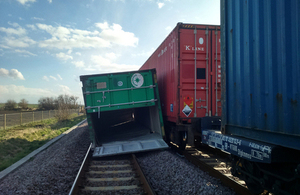Container blown off a freight train in Lincolnshire
Detachment of a container from a moving freight wagon near Deeping St Nicholas, Lincolnshire, 31 March 2015

Container on the adjacent track (Image courtesy of Network Rail)
On 31 March 2015, at around 15:22 hrs, an empty 40 feet container was blown from a FEA(S) wagon that formed part of the 11:21 hrs GB Railfreight service from Felixstowe South to Doncaster Railport. The train was travelling at approximately 38 mph (61 km/h) on the Down Spalding line when the container fell. The container became caught up with the train and was dragged a short distance before coming to rest on the adjacent track. The train continued approximately 250 metres before being brought to a stand by the train’s automatic brake. This was applied when the container struck the handbrake handwheels of several wagons and damaged a safety mechanism. The incident took place at a time of high cross winds.
Significant damage was caused to the infrastructure, including a trackside telecommunications cabinet, sleepers and rail fixings and axle counter heads. There were no trains passing at the time of the incident although a freight train had passed on the adjacent line about five minutes before the incident. The potential for more serious consequences is evident.
The wagon was fitted with UIC spigots on which the container was mounted. The ability of spigots to retain containers subject to overturning forces, such as those developed in high cross winds, is dependent on compliance with the dimensional tolerances specified in standard UIC 571-4. However, the RAIB’s investigation of previous similar incidents at Hardendale and Cheddington in 2008 found that inwardly hinging spigots, of the same type as those on FEA(S) wagons, do not meet the UIC standard and are unable to resist the overturning forces experienced in strong winds.
Following RAIB’s report on the Hardendale and Cheddington investigation, GB Railfreight addressed the risk of containers blowing off in strong winds procedurally by imposing a maximum speed of 60 mph (97 km/h) for trains carrying empty containers on FEA(S) wagons when wind speeds of between 56 and 65 mph (90 and 105 km/h) are forecast, or by removing empty containers altogether when wind speeds of more than 65 mph (105 km/h) are forecast.
On 31 March 2015 Network Rail’s National Operations Centre issued a strong wind warning to freight companies referring to expected wind gusts of 55 to 60 mph (89 to 97 km/h) with peaks of up to 65 mph (105 km/h) during the afternoon in central areas of England. In accordance with GB Railfreight’s own procedures a speed limit of 60 mph (97 km/h) was applied for the train’s journey from Felixstowe to Doncaster.
In the event, while an average wind speed of around 54 mph (87 km/h) was measured at nearby weather stations around the time of the incident, data from a wind farm close to the site indicates that there were higher localised gusts in the 10-minute interval during which the incident occurred.
This incident follows a similar event at Scout Green, Cumbria on 7 March 2015 which RAIB is also investigating and was the subject of an Urgent Safety Advice to the railway industry. On 2 April 2015 Network Rail issued an instruction to freight operating companies requiring empty containers carried on wagons with non-compliant UIC spigots to be mechanically locked to the wagon or removed from the train, pending the conclusion of investigations into this and the Scout Green incidents.
Our investigation will consider the factors that led to this further incident, including actions taken to rectify the deficient design of this type of spigot in line with the recommendation made in the Hardendale and Cheddington report.
Our investigation is independent of any investigations by the railway industry or safety authority.
We will publish our findings at the conclusion of the investigation. This report will be available on our website.
You can subscribe to automated emails notifying you when we publish our reports and bulletins.